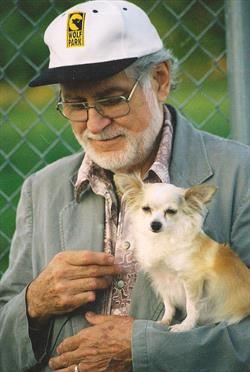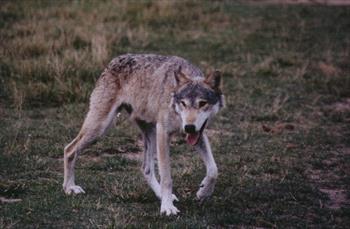Over 20 years ago, when I became interested in dog training and animal behavior, I frequently heard statements such as, “Well, in the wild, the alpha wolf eats before subordinates and walks ahead of them.” Then later I’d hear someone say, “That’s wrong, they don’t do that at all.” So how do you find out what’s right? You could crack open any current book by Dr. David Mech, the most notable wolf biologist alive. Or you could take a course at a respected conservations and research park study wolves, such as Wolf Park in Indiana. I did just that back in 1999. Here’s an overview of my one week trip.
Wolf Park founded by the Northern American Wildlife Park Foundation for the study and preservation of wolves, is a 75-acre wildlife park where wolves live in a large semi-natural enclosures in large and small parks. The wolves at Wolf Park are tamed through an intensive hand-raising process so that they can be observed exhibiting their natural social behaviors. In the wild, wolves have an intense fear of humans and are rarely seen, making research on their natural behavior difficult to observe.
Unlike dogs, wolf pups must be removed from their parents before two weeks of age and hand raised by humans through the age of four months in order to be tamed. Pups who are not hand-raised become extremely fearful of humans even in cases where the rest of the pack is tame and humans interact with the puppies extensively everyday.
Once a week the main wolf pack is allowed to hunt the resident bison herd. Contrary to what you might expect, the bison do not seem nervous when the wolves appear. Some remain lying down while others continue grazing and ruminating. The wolves don’t stalk the bison the way a border collie stalks the sheep it’s herding. Rather, they nonchalantly walk around the herd inconspicuously looking for subtle signs of weakness. Occasionally they square off with an individual but usually within a second of two the individual chases them away. If it’s a calf that is being tested, its mother comes to the rescue. Because none of the herd members have been sick at the time of the hunt, no bison have ever been killed in the 20 years of the hunt at Wolf Park.
Read about Wolf Hybrids.
The wolves at Wolf Park are tame enough to interact with visitors attending the behavior courses. Like dogs, they look forward to interacting with staff members daily. They run up to greet the members and even offer kisses and beg for rummy rubs. They go through the same motions that your pet dog may show; but the interaction feels oddly detached. It’s like they are just interacting with us out of convenience to themselves but that we are as important as a rock or a tree.
Wolves are also less accepting of other individuals compared to dogs and are likely to become fearful or aggressive if an individual they know acts oddly. As a result, even veteran wolf-handlers have to be careful around the wolves. At Wolf Park, even routine interaction with the wolves requires two people present for safety reasons. Additionally, when sick or on medications, handlers do not go in with the wolves. Even a wolf’s favorite person can be the object of aggression is he is sick.
Wolves in the wild live in family units where a male and female have offspring and due to their experience, they naturally become the highest ranked over their offspring without having had to fight for their spot. Their offspring just naturally defer to them. Consequently, wolf biologists do not refer to leaders of these family units as alphas—alpha implies a fight was required for status.
In captivity, wolves live in mixed packs instead of family units and do fight to attain their rank. The males and females have separate hierarchy; hence there’s an alpha female and alpha male. In fact it’s the study of wolves in captivity that lead wolf biologists to erroneously think that all wolves fought to attain rank in a group.
In captivity, the desire to be high ranked in a mixed pack is quite high and wolves are frequently looking for opportunities to overthrow those who are ranked above them. In fact taking a high ranked wolf out of the group for a prolonged period (such as a day or two) can lead to increased fighting amongst the others and possibly fighting when the wolf is reintroduced.
Wolves in the Wild
Wolves in the wild probably live to about five or seven years of age. They succumb to starvation, predation by humans, parasites, broken bones, and other injuries. In captivity, wolves live closer to 10–12 years of age. Wolves get all of the same medical problems as dogs including hot spots, diabetes, and kidney disease. In the wild, the ones that develop these diseases die younger and produce less offspring.






